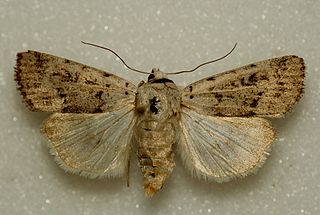
Schinia, commonly called flower moths, is a large genus of moths belonging to the family Noctuidae. The genus has a Holarctic distribution with the vast majority of species being found in North America, many with a very restricted range and larval food plant.

Anicla is a genus of moths of the family Noctuidae.

Euxoa tronellus is a moth of the family Noctuidae first described by Smith in 1903. It is found in western North America from western North Dakota and South Dakota, west across southern Saskatchewan and southeastern Alberta to Washington, south to southern California and northern New Mexico.

Euxoa medialis, the median-banded dart, is a moth of the family Noctuidae. The species was first described by Smith in 1888. It is found in North America from southern Manitoba and central Wisconsin, west to southwest Alberta and California; north to southern Alberta and south to south-central Mexico.
Abagrotis erratica is a moth of the family Noctuidae first described by Smith in 1890. It is found in North America from southern British Columbia including Vancouver Island south to central Utah and central California. It is also found in extreme southern Alberta.
Abagrotis trigona, the luteous dart, is a moth of the family Noctuidae. The species was first described by Smith in 1893. It is found in North America from western South Dakota and south-western Manitoba west across southern Saskatchewan and Alberta to Vancouver Island, south to the Mexican border. There is also a disjunct population in Ohio.

Acronicta mansueta, the gentle dagger moth, is a moth of the family Noctuidae. The species was first described by Smith in 1897. It was considered a synonym of Acronicta falcula, but was reinstated as a valid species in 2011. It is widespread in western North America, from southern Saskatchewan west to southern British Columbia, and south to at least Colorado and California.

Sympistis glennyi is a moth of the family Noctuidae first described by Augustus Radcliffe Grote in 1873. It is found in western North America from the mountains of southern Alberta west to British Columbia and south at least to Colorado and California.

Anicla tepperi is a moth of the family Noctuidae first described by Smith in 1888. It is found in North America from eastern Manitoba west to the Alberta foothills, north to about Lloydminster and south to southern Colorado.

Apamea commoda, the southern Quaker, is a moth of the family Noctuidae. The species was first described by Francis Walker in 1857. It is native to North America, where it is distributed from Nova Scotia west across southern Canada to southern British Columbia, north to Alaska and Yukon Territory, and south at least into Manitoba.
Apamea contradicta, the northern banded Quaker, is a moth of the family Noctuidae. The species was first described by Smith in 1895. It is native to northern North America, where it can be found across southern Canada from Newfoundland and Labrador west to Alberta and south to Colorado.
Rhizagrotis stylata is a moth of the family Noctuidae first described by John Bernhardt Smith in 1893. It is found in North America from south-eastern Alberta south to at least Arizona.

Colocasia propinquilinea, the closebanded yellowhorn, is a moth of the family Noctuidae. The species was first described by Augustus Radcliffe Grote in 1873. It is found in North America from Newfoundland and Labrador, west across the southern edge of the boreal forest to central Alberta, south to North Carolina, Missouri and Arkansas.

Copablepharon grandis, the pale yellow dune moth, is a moth of the family Noctuidae. The species was first described by Strecker in 1878. It is found in North America from southern Alberta east to south-western Manitoba, the eastern parts of South Dakota, North Dakota and Iowa, west to California and south to southern Arizona, New Mexico and western Texas.
Euxoa atomaris is a moth of the family Noctuidae first described by Smith in 1890. It is found in North America from North Dakota, southern Alberta and British Columbia, south to central New Mexico, Arizona and southern California.
Euxoa aurulenta, the dune cutworm, is a moth of the family Noctuidae. The species was first described by Smith in 1888. It is found in North America from Ontario west to Alberta and Washington, south to Illinois, Nebraska, Colorado and Arizona.
Euxoa dargo is a moth of the family Noctuidae first described by Strecker in 1898. It is found in North America from south-eastern Manitoba west to the southern interior of British Columbia, south to Oregon, southern Idaho and northern New Mexico, and east to eastern South Dakota.
Diarsia calgary, the Calgary dart, is a moth of the family Noctuidae. The species was first described by Smith in 1898. It is found in North America in the mountains and foothills from Yukon, south to Arizona and New Mexico, west to the coast of British Columbia. There is a disjunct population in central western California.

Euxoa edictalis is a moth of the family Noctuidae first described by Smith in 1893. It is found in North America from south central Alberta and east-central Montana, west to south-central British Columbia, south to central California, southern Nevada, central Utah and western Colorado.

Melanolophia imitata, the western carpet or green-striped forest looper, is a moth of the family Geometridae. The species was first described by Francis Walker in 1860. It is found in western North America from southern California, north to Alaska and east to extreme south-western Alberta.









